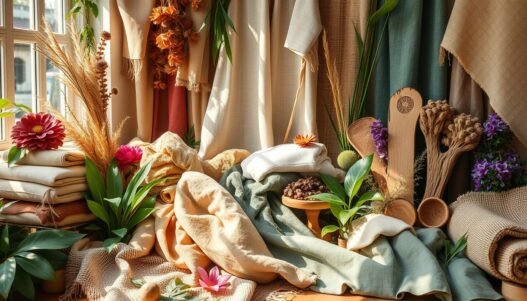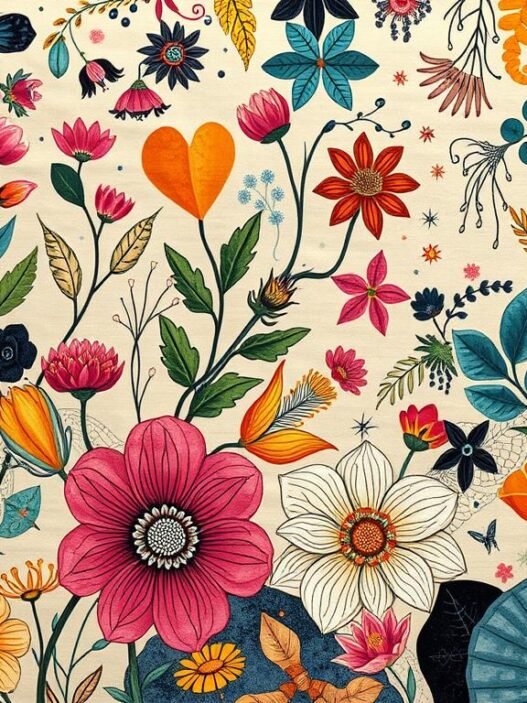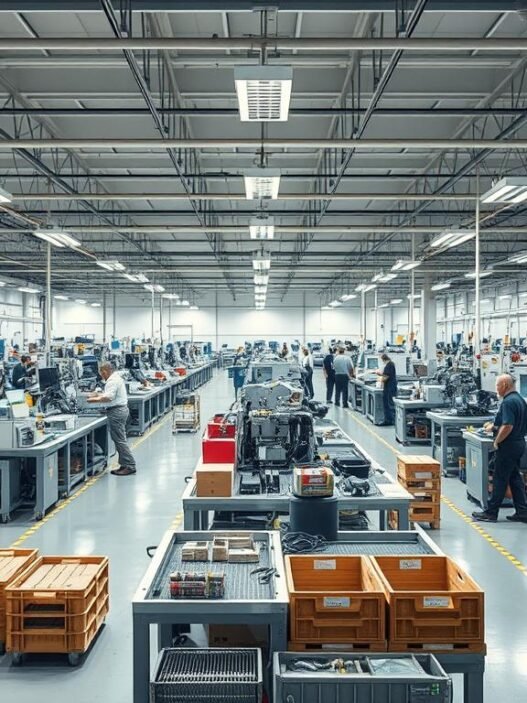Did you know the textile industry is a big contributor to greenhouse gas emissions? It’s responsible for about 1.7 million tons of CO2 every year. This shows how important it is to use eco-friendly fabrics to reduce our environmental impact.
As we all try to be more sustainable, looking into sustainable textiles is key. It’s a step towards a greener future for all of us.
Eco-friendly textiles are made to be kinder to our planet. They’re designed to reduce harm from start to finish. Choosing these fabrics helps us care for our planet and makes our wardrobes more ethical.
This article will explore eco-friendly textiles in depth. We’ll talk about why they’re important, what makes them special, and the new tech in sustainable fashion. You’ll learn how your fabric choices can help make the future greener.
Key Takeaways
- The textile industry contributes significantly to CO2 emissions, making eco-friendly solutions crucial.
- Eco-friendly textiles minimize environmental impacts throughout their lifecycle.
- Natural fibers like hemp and linen are praised for their sustainability.
- Brands are increasingly adopting sustainable practices in response to consumer demand.
- Understanding textile options is essential for making informed fashion choices.
The Importance of Sustainable Fabrics
The fashion industry has a big impact on the environment. It uses a lot of resources and creates pollution. We need sustainable fabrics to make things better.
Environmental Impact of the Fashion Industry
The textile industry is a big polluter and uses a lot of resources. It uses a lot of water and makes a lot of carbon emissions. Using sustainable fabrics can help fix these problems.
For example, organic cotton farming is better for the environment. It doesn’t use harmful chemicals. Fabrics like Tencel and hemp also need less resources and help the environment.
Consumer Demand for Eco-friendly Products
More people want to buy sustainable fabrics. They are willing to pay more for them. This makes brands want to use sustainable practices.
Brands that use recycled materials are popular. They make products that are good for the planet. This helps create a better future.
| Fabric Type | Environmental Benefits | Key Features |
|---|---|---|
| Organic Cotton | No harmful chemicals | Soft, breathable, sustainable |
| Tencel/Lyocell | Closed-loop production | Soft, biodegradable, high moisture absorption |
| Hemp | Minimal water and pesticide use | Durable, breathable, renewable |
| Recycled Polyester | Reduces plastic waste | Durable, versatile, lightweight |
What Makes a Textile Sustainable?
Understanding what makes textiles sustainable is key for both buyers and makers. Sustainable textiles care for the environment at every step. This includes how materials are sourced, processed, and disposed of.
They tackle big issues like carbon emissions, using resources, and waste. This shows a real commitment to being green.
Sourcing of Raw Materials
Choosing eco-friendly materials is at the heart of sustainable textile sourcing. Fabrics like organic cotton, TENCEL, and hemp are great examples. They help reduce harm to the environment.
With more people wanting sustainable materials, brands that choose responsibly are ahead. Labels like GOTS Organic and BLUESIGN check if materials are up to environmental standards.
Material Processing Techniques
How textiles are made is also crucial for sustainability. Techniques that save water and energy, and avoid bad chemicals, are sought after. For example, Lyocell’s closed-loop process cuts down waste and environmental harm.
By using green production methods, makers can make textiles better for the planet. This meets the needs of eco-conscious consumers.
Lifespan and End-of-Life Disposal
The length of time textiles last is important for sustainability. Durable fabrics mean less need for new ones. This reduces waste in landfills.
Recycling and biodegradability are also key. Textiles like recycled polyester and organic cotton can be reused or break down naturally. This shows the cycle of sustainable fashion.
Eco-friendly Textiles to Consider
Looking into eco-friendly textiles shows us many sustainable materials. These materials greatly lessen harm to the environment. By choosing organic cotton, recycled textiles, hemp, and linen, we support a world where fashion and nature go hand in hand. Knowing the benefits and differences helps us make better choices for our clothes.
Organic and Recycled Cotton
Organic cotton is a top choice for its eco-friendliness. It uses 62% less energy and 88% less water than regular cotton. It also avoids harmful pesticides, making it safer for farmers and the planet. Recycled cotton, on the other hand, is great for reducing waste by turning old clothes into new ones. This method is kinder to the earth and supports a closed-loop system.
Hemp and Linen Fabrics
Hemp is a standout for its hemp linen sustainability. It needs only a third of the water cotton does and is three times stronger. This makes hemp fabrics a big help in reducing waste. Linen, made from flax plants, also needs less water and supports green practices in the textile world. Both hemp and linen are durable and help lessen environmental damage.
Recycled Polyester Advantages
Polyester is a big part of the fashion world, but it’s bad for the environment, causing 40% of the industry’s carbon emissions. Recycled polyester, made from plastic bottles, uses less energy and resources than new polyester. Choosing recycled polyester is a big step towards a more eco-friendly wardrobe.
| Textile Type | Water Usage | Durability | Environmental Impact |
|---|---|---|---|
| Organic Cotton | 62% less than conventional | Low | No pesticides; reduced resource consumption |
| Recycled Cotton | Minimal | Medium | Reduces landfill waste; circular economy |
| Hemp | One-third of cotton | Three times more than cotton | Carbon-negative; durable |
| Linen | Less than cotton | Medium | Low resource requirement; sustainable |
| Recycled Polyester | Less than virgin polyester | Medium | Reduces energy consumption; decreases waste |
Innovative Textile Technologies
The textile industry is changing fast, focusing on sustainable technologies. Brands now make eco-friendly products while keeping quality high. The LYCRA EcoMade line shows how you can have both performance and sustainability.
EcoMade Products by LYCRA®
LYCRA EcoMade leads in textile innovation, using recycled materials. This cuts down on environmental harm from making fabrics. It keeps the quality of LYCRA fibers and meets the demand for green products.
These fabrics are not only comfortable but also good for the planet.
Closed-Loop Manufacturing Processes
Closed-loop systems are key for sustainable textiles. Companies like TENCEL™ recycle water and solvents, reducing waste and protecting ecosystems. This shows how new tech can make production greener and more efficient.
These systems help save resources and cut down on waste, making textiles more sustainable.
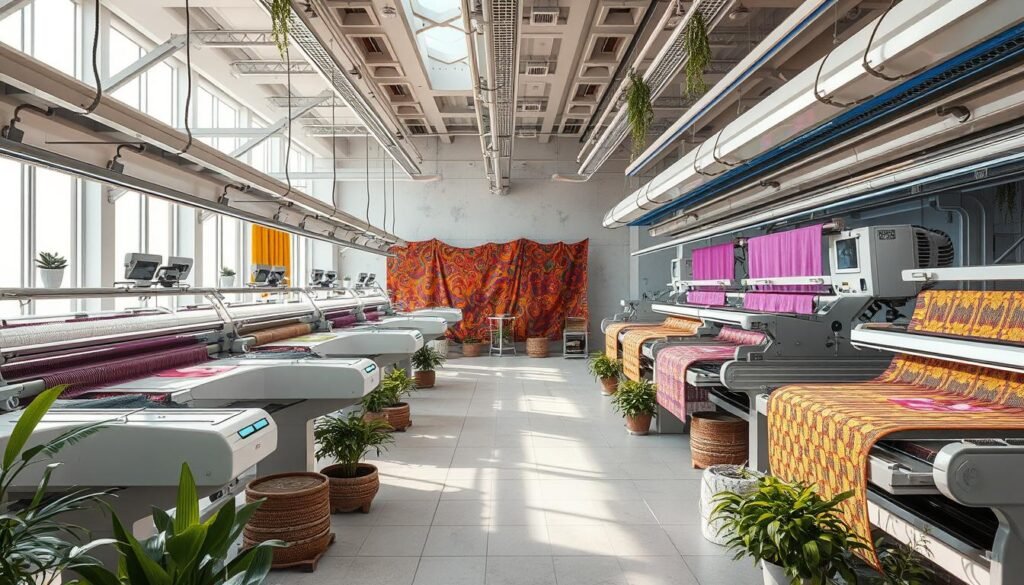
| Innovative Technology | Description | Environmental Benefit |
|---|---|---|
| LYCRA EcoMade | High-performance fibers from recycled materials | Reduces reliance on virgin resources |
| Closed-Loop Systems | Processes that recycle water and solvents | Minimizes waste and lowers carbon footprint |
| Economy of Innovations | Using by-products to create new fabrics | Enhances resource efficiency and waste management |
The Benefits of Choosing Sustainable Fabrics
In today’s world, choosing sustainable fabrics is key for both buyers and sellers. Eco-friendly textiles make products last longer and help our planet. Knowing these benefits can change how we shop, saving money and boosting brand image.
Longer Lasting Products
Sustainable fabrics like organic cotton and hemp last longer than synthetic ones. This means you don’t need to buy new things as often. It saves money and supports sustainable living.
Cost Savings and Value for Consumers
Going for sustainable fabrics saves money and is better for the planet. Making these materials is safer for people and the environment. It also means you spend less on buying and throwing away things.
Improved Brand Image for Businesses
Companies that go green get a better reputation. More people want to buy from brands that care about the planet. This makes customers trust them more and builds strong relationships in a competitive market.
Challenges in the Sustainable Textile Industry
The sustainable textile industry faces many challenges, mainly because of fast fashion. This fast fashion makes it hard to be truly eco-friendly and accountable in fabric making. It makes consumers and brands struggle to find real sustainability in the market.
Fast Fashion and Its Impact on Sustainability
Fast fashion is a big problem for sustainable textiles. It pushes for quick production and low prices, leading to more clothes being thrown away. This results in a lot of textiles ending up in landfills, where they take years to break down and harm the environment.
It also drains water in areas where water is scarce. The use of synthetic fabrics adds to the problem by releasing microplastics when washed. This pollutes our water systems.
Misleading Marketing Tactics
Greenwashing is another big issue in sustainable textiles. It tricks consumers into thinking some products are more sustainable than they really are. Without clear rules, it’s hard to tell what’s truly eco-friendly from what’s just pretending to be.
Companies might say their fabrics are organic or recyclable but not really follow strict green standards. This makes it hard for people who know better to trust these claims.
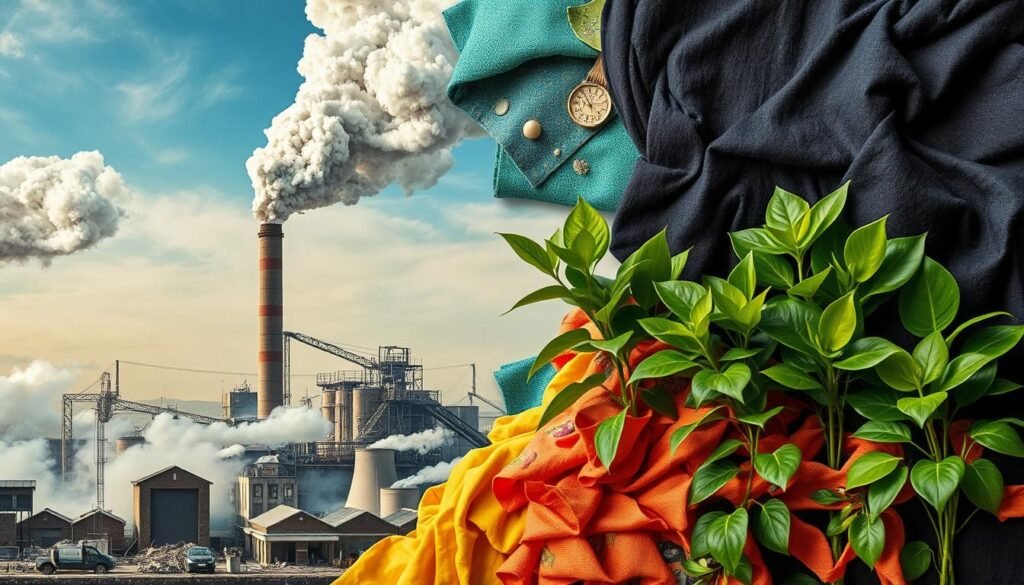
| Challenges | Impact on Sustainability |
|---|---|
| Fast Fashion | Overproduction and waste, increased landfill contributions, and microplastic pollution |
| Greenwashing | Confusion among consumers, lack of transparency, and diminished trust in eco-friendly claims |
| Water Consumption | Depletion of water resources, pollution from chemicals, and harm to aquatic ecosystems |
| High Energy Consumption | Substantial greenhouse gas emissions and reliance on non-renewable energy sources |
| Textile Recycling Challenges | Low recycling rates and difficulties in processing diverse materials |
How to Identify Sustainable Fabrics
Consumers are key in making the textile industry more sustainable. They can start by looking at certification standards. These standards show if products meet environmental and social rules. Knowing how materials are made and what happens to them at the end is also important.
Certifications to Look For
There are several certifications that help spot sustainable fabrics:
- Global Organic Textile Standard (GOTS): Makes sure fibers are organic and made in green ways.
- OEKO-TEX Standard 100: Checks if textiles have harmful stuff in them.
- Better Cotton Initiative (BCI): Works to make cotton farming better for the planet.
- Bluesign: Looks at making production more efficient and green.
Understanding Material Life Cycles
It’s vital to understand how materials are made and used. The key parts are:
| Stage | Details |
|---|---|
| Sourcing | Getting raw materials like organic cotton, hemp, or lyocell without bad chemicals. |
| Processing | Using green methods that use less water and air pollution. |
| Manufacturing | Checking for fair work and clear supply chains, like Patagonia does. |
| Use | How long the product lasts and how it affects the planet. |
| End-of-life | If the fabric can break down or be recycled, reducing waste. |
Future Trends in Eco-friendly Textiles
The world of sustainable fashion is changing fast. Brands are now focusing on eco-friendly options. This shift is expected to make sustainable fashion worth over $10 billion by 2025.
Growing Market for Sustainable Fashion
More people want clothes that are good for the planet. This demand is pushing brands to use materials like organic cotton and hemp. Working together, designers, brands, and makers are making fashion more sustainable.
Innovations in Material Sourcing
New materials are changing the textile world. For example, Piñatex comes from pineapple leaves and Tencel from wood pulp. These options are better for the environment and help brands reduce their impact.
Also, recycling and dyeing without water are becoming more common. Brands are taking back old clothes to recycle them. Using blockchain helps keep the supply chain honest. All these steps are making fashion more sustainable.
| Fabric Type | Key Features | Environmental Impact |
|---|---|---|
| Organic Cotton | Grown without synthetic pesticides | Promotes soil health |
| Hemp | Durable and low-resource requirement | Requires minimal water and pesticides |
| Tencel (Lyocell) | Biodegradable and soft | Sustainable wood pulp sourcing |
| Piñatex | Alternative to leather | Utilizes waste materials |
| Recycled Fabrics | Made from post-consumer waste | Reduces landfill contributions |
To learn more about sustainable textiles and the latest innovations, visit sustainable textile innovations.
Consumer Choices and Eco-friendly Textiles
The fashion world is under fire for its harm to the environment. What we choose to buy matters a lot. Fast fashion is bad, causing 20% of global wastewater and 10% of carbon emissions. Choosing sustainable fabrics helps reduce waste and supports quality over quantity.
Making Informed Purchasing Decisions
When we pick sustainable fabrics, we help a big movement. It’s key to know the impact of buying clothes made from eco-friendly materials like organic cotton and recycled polyester. By choosing brands that care about the planet, we push for better practices in the industry.
Supporting Ethical Brands
Backing companies that care about the planet is crucial. Look for brands with certifications like WRAP, showing they follow ethical standards. Buying clothes made from biodegradable or recycled materials helps the environment. It’s a way to support fair practices and a healthier planet.
Conclusion
The shift to eco-friendly textiles is a big change for the fashion world. Choosing options like organic cotton and recycled polyester saves water and cuts down pollution. This is key because the fashion industry causes a lot of harm to our planet.
By picking eco-friendly clothes, we support brands that care about the environment. This movement makes people more aware of the impact of their choices. It also makes clothes last longer and reduces waste.
Choosing sustainable fabrics is a step towards a better planet. It shows we care about the future of our environment. Making smart choices in what we wear is crucial for a greener future.





